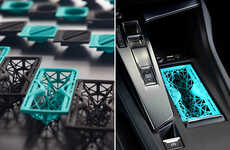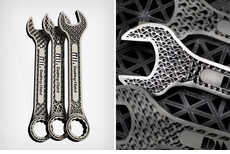
The DeltaWing Race Car Engine Was Created with Additive Manufacturing
Laura McQuarrie — April 2, 2015 — Autos
References: 3ders.org
A testament to the practical applications of 3D printing for the automotive industry is that the professional racing DeltaWing uses 3D-printed car parts. The DeltaWing was first debuted at the 24 Hours of Le Mans back in 2012, but it continues to evolve at the same speed as technology.
What really sets the DeltaWing apart is its lightweight body, power and low drag. These features make the car supremely sustainable because it requires less fuel and tire replacements during a race. Engineer Christian Yaeger continues to improve on the design of the car by implementing a 3D-printed intake manifold, the part of the engine that provides air to the cylinders. This component was created in a composite called Windform SP, a polyamide based material that's filled with carbon. Although the shaping of the engine part was a challenge, CAD software was integral to problem solving. As Yaeger says "We could not have made this motor happen if we couldn’t produce parts directly from CAD files."
What really sets the DeltaWing apart is its lightweight body, power and low drag. These features make the car supremely sustainable because it requires less fuel and tire replacements during a race. Engineer Christian Yaeger continues to improve on the design of the car by implementing a 3D-printed intake manifold, the part of the engine that provides air to the cylinders. This component was created in a composite called Windform SP, a polyamide based material that's filled with carbon. Although the shaping of the engine part was a challenge, CAD software was integral to problem solving. As Yaeger says "We could not have made this motor happen if we couldn’t produce parts directly from CAD files."
Trend Themes
1. 3d-printed Automotive Parts - The use of 3D printing technology in the automotive industry for creating lightweight and sustainable car parts.
2. Composite Materials in 3D Printing - The development of composite materials like Windform SP for 3D printing that combine strength and lightweight properties.
3. CAD Software for Precise Engineering - The utilization of CAD software in designing and problem-solving for 3D-printed car parts.
Industry Implications
1. Automotive Manufacturing - Opportunity for automotive manufacturers to adopt 3D printing technology to create lightweight and sustainable car parts, reducing fuel consumption and improving performance.
2. Composite Material Manufacturing - Opportunity for companies in composite material manufacturing to develop innovative materials specifically designed for 3D printing in automotive applications.
3. CAD Software Development - Opportunity for software companies to improve and advance CAD software for the precise engineering of 3D-printed car parts, enhancing the design and manufacturing process.
2.7
Score
Popularity
Activity
Freshness























